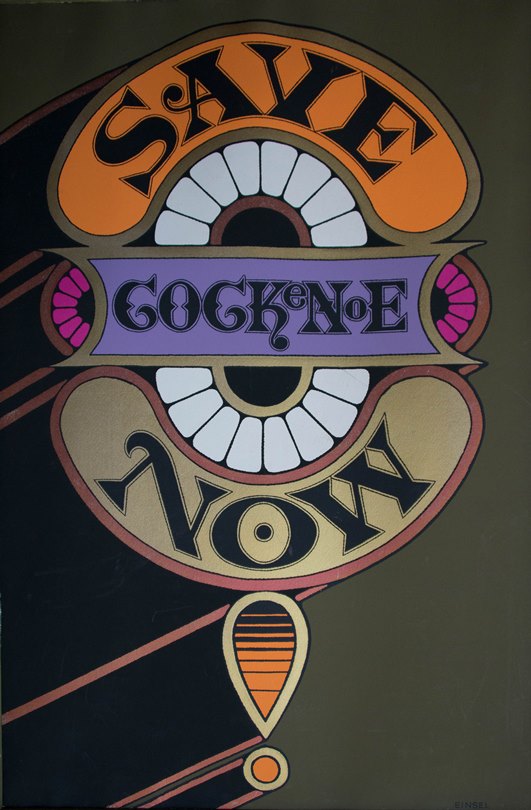By Nancy Finlay
In the middle of the 17th century, a Native American known as Cockenoe or Checkanoe, signed a deed giving an island (now known as Cockenoe Island) to the fledgling town of Norwalk. Just over 180 years later, in 1835, the island became a part of Westport, when that municipality emerged from parts of Norwalk, Fairfield, and Weston. Over the years, the twenty-odd-acre Cockenoe island served as a farm and also a whiskey distillery, but by the mid-20th century, it returned to an uninhabited strip of sand and scrub frequented by fishermen, clammers, duck hunters, and nature lovers.

Naiad Einsel, Save Cockenoe Now, 1967, oil on canvas – Westport Historical Society
Then, in the mid-1960s, the Bridgeport-based power company United Illuminating (UI) acquired the island. In August of 1967, the company announced plans to build a nuclear power plant on the island.
Controversy over Construction on Cockenoe Island
Although a 1964 movie filmed in nearby Stamford, The Horror of Party Beach, featured an atomic mutation that terrorized beachgoers, during the early 1960s atomic energy remained widely regarded as safe and clean and a positive alternative to traditional energy sources such as burning coal. Atomic power plants served populations all over the United States and several Westport residents viewed the construction of the Cockenoe plant as part of the inevitable march of progress. But many others bristled at the idea of a nuclear power plant just off their coast, especially after learning that the plan called for the plant to be 14 stories high and connected to the mainland by a causeway. This threatened to permanently alter the nature of the coastline.
To prevent construction, the town of Westport voted to acquire the island, but United Illuminating refused to sell it. Although the island remained zoned for “residential use only,” United Illuminated counted on obtaining a zoning variance from the State Public Utilities Commission based on “public need.” The power company insisted that even after the plant’s construction, however, they intended to leave a portion of the island available to the public for recreational use.
Grassroots Activism Returns Cockenoe Island to the Town of Westport
Local legislators and journalists joined forces with ordinary citizens in an attempt to stop the construction of the power plant. Protesters collected editorials opposing the power plant and gathered photographs showing children and adults picnicking and swimming on the island (which they sent to state legislators and major media). They even produced a film touting the recreational uses of the island.
On March 10, 1969, hundreds of Westport residents traveled to the Connecticut State Capitol in Hartford to support a bill giving Connecticut towns priority over utility companies in cases of eminent domain. Immediately afterward, United Illuminating called Westport’s town attorney, offering to sell the island. The town of Westport bought the property for just over $200,000 and designated it as open space. Life magazine, in a special Fourth of July issue in 1970, called it “one of the most significant conservation victories in the nation.” Today, Cockenoe Island remains an uninhabited strip of sand and scrub, the site of successful nesting colonies of egrets, herons, terns, and cormorants.
Nancy Finlay grew up in Manchester, Connecticut. She has a BA from Smith College and an MFA and PhD from Princeton University. From 1998 to 2015, she was Curator of Graphics at the Connecticut Historical Society.









